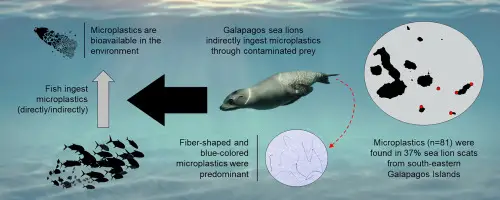Se detectaron microplásticos en el 37 % de las muestras de heces del lobo marino de Galápagos.
Andrés Moreira-Mendieta, Odei Garcia-Garin, Juan Pablo Muñoz-Pérez, Diego O. Urquía, Massimiliano Drago, Asunción Borrell, Diego Páez-Rosas.
Resumen
La contaminación por desechos marinos representa una amenaza global significativa para la biodiversidad, siendo los plásticos el tipo principal de desechos encontrados en los océanos debido a su producción económica y alta demanda en todo el mundo. Los microplásticos (MPs, <5 mm de tamaño) son altamente biodisponibles para una amplia gama de taxones marinos, incluyendo mamíferos marinos, a través de rutas de ingestión directa e indirecta (es decir, transferencia trófica). Recientemente, se ha detectado contaminación por MPs en la Reserva Marina de Galápagos, por lo que en este estudio desarrollamos un marco de referencia inicial para la contaminación por MPs en el lobo marino de Galápagos (GSL, Zalophus wollebaeki) mediante un análisis basado en las heces. Recopilamos 180 muestras de heces de GSL en la región sureste siguiendo estrictos protocolos de control de calidad para detectar, cuantificar y caracterizar las propiedades físico-químicas de los MPs a través de observaciones visuales y espectroscopía μFT-IR. Recuperamos 81 MPs de diversos tamaños y colores en el 37 % de las muestras (n = 66/180), compuestos principalmente por fibras (69 %, = 0.31 ± 0.57 partículas por muestra de heces). El número de partículas por gramo de peso húmedo de la muestra varió de 0.02 a 0.22 ( = 0.04 ± 0.05 partículas por gramo de heces húmedas). Las colonias de El Malecón y Punta Pitt en la Isla San Cristóbal tuvieron el mayor número de MPs ( = 0.67 ± 0.51 y 0.43 ± 0.41 partículas por muestra de heces, respectivamente), y las partículas de color azul fueron las más comunes en todas las muestras. Identificamos once polímeros en 46 partículas, compuestos principalmente por copolímero de polipropileno-polietileno, polipropileno, celulosa, polietileno y cloruro de polivinilo. Las industrias textiles, pesqueras y de embalaje son probablemente fuentes significativas de microfibras en este ecosistema insular. Nuestros resultados sugieren que el GSL está expuesto a MPs debido a la contaminación antropogénica que luego se transfiere a través de procesos tróficos. Estos hallazgos proporcionan un marco de referencia importante y conocimientos para futuras investigaciones sobre la contaminación por MPs en la región, así como para acciones de manejo que contribuirán a la conservación a largo plazo del GSL.
Conoce más aquí.






